News/Media & Resources
Newsboy
Recipe of the Month: Pumpkin Coffee Cake
Energy Efficiency Tip of the Month
Concern for Community: REC employees volunteer at Care & Share
Meet Your Coop: Barr completes apprenticeship, journeys out
Meet Your Coop: Sanford native joins REC crews as journeyman
Exploring the jagged frontier of AI innovation by Eric Eriksen
Concern for Community: Valley students benefit from Tri-State school supply drive
Recipe of the Month: Asparagus Pasta
Member Information: Saving energy during peak times benefits all
Member Information: Board reduced to six directors
Safety Tips
Home safety: Ground fault circuit interrupters vs. arc fault circuit interrupters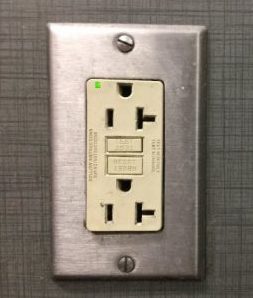
The world of electricity is filled with acronyms and abbreviations – CFL (compact florescent lamp), kW (kilowatt), AC (alternating current), and POV (peak operating voltage). GFCI (ground fault circuit interrupters) and AFCI (arc fault circuit interrupters) are also common electrical abbreviations. They both help protect your outlets from electrical accidents.
Ground fault circuit interrupters help prevent burns, electric shocks, and electrocution. A GFCI has sensors that measure the current going in and out. Normally, the current is balanced. However, if the current is out of balance, something is wrong. The electric current has made contact with a human or somewhere else it should not be. The GFCI senses this and instantly shuts down the circuit, stopping the flow of electricity. Since water is an electric conductor, GFCIs are important in areas where water and electricity could meet, such as bathrooms, kitchens, laundry rooms, and garages.
Arc fault circuit interrupters help prevent electric fires. Electricity can leak out of damaged or decaying wires and start a fire. These fires spread quickly in the wiring behind walls. Electric fires cause more damage than some other types of fire and are twice as deadly. AFCIs sense electricity is leaking from the electric system and shut electricity off before overheating happens.
GFCIs prevent shocks, and AFCIs prevent fires. Both should be installed by a qualified electrician to make your home safer.
Staying safe and warm during a winter storm
Winter can bring high winds, sub-zero temperatures, and ice to many parts of the country. Such dangerous winter weather can cause hazardous road conditions, downed power lines, and extended power outages. Be sure to stay safe before, during, and after a winter storm hits. Click here to read more.
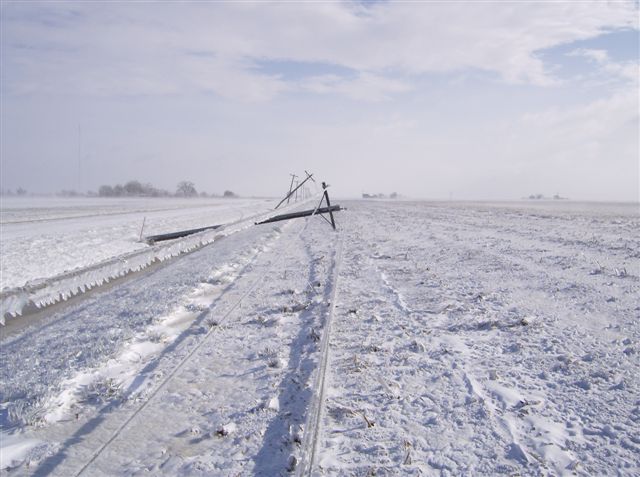
History of SLV Rural Electric Cooperative
Rural Electrification Act of 1936:
Nearly 1,000 RECs were formed, not for profit, but to supply electricity to their own citizens. Two purposes: Extend power lines into rural areas & employ the unemployed during the Great Depression
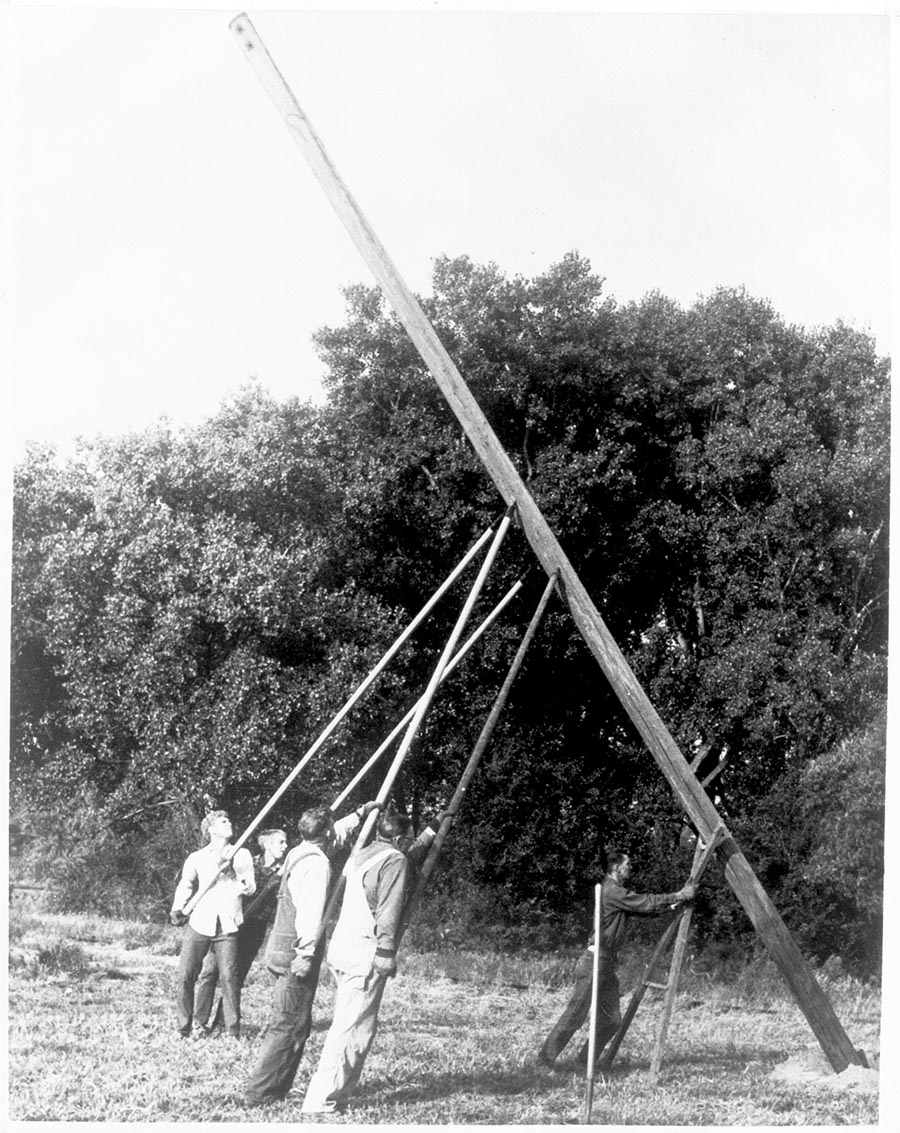
Mid-July 1937:
The SLV rural electric project began as two separate projects— Alamosa Rural Electric Company, which included the southern part of Alamosa County, part of Conejos County and the Bowen Community in Rio Grande County and the REA, which included most of Rio Grande County (those not with Public Service), the southern part of Saguache County and the northwest part of Alamosa County.
In mid-July 1937 it was approved as one joint San Luis Valley project to be named San Luis Valley Rural Electric Cooperative. $150,000 was approved for the project to include construction of approximately 225 miles of power lines in Rio Grande and Saguache counties with 586 customers plus 100 miles of line and 200 customers in Alamosa and Conejos counties.
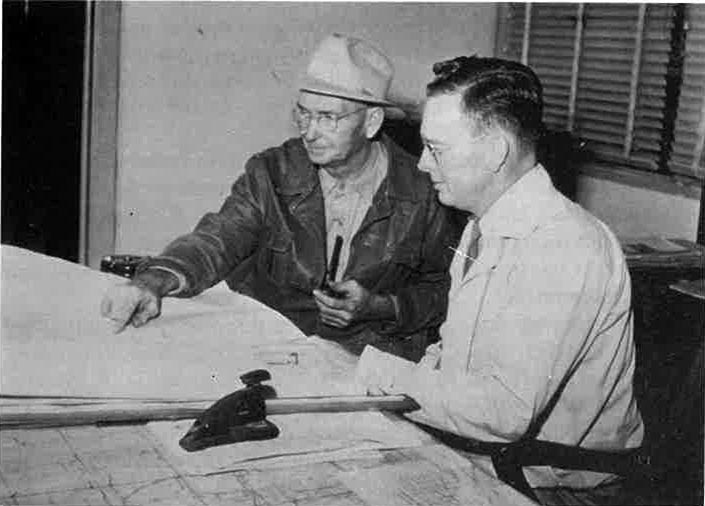
Planning power line locations
Aug. 10, 1937: San Luis Valley REC incorporated
Back row, Frank McGee (Saguache County agent at time of incorporation in 1937): Ray Moses, first REC attorney; Max Sutley, Clyde Helms Sr., J.V. Edgmand, Herbert Bowers and Arthur Robertson
—all among the 14 incorporators. Wives are seated in front.
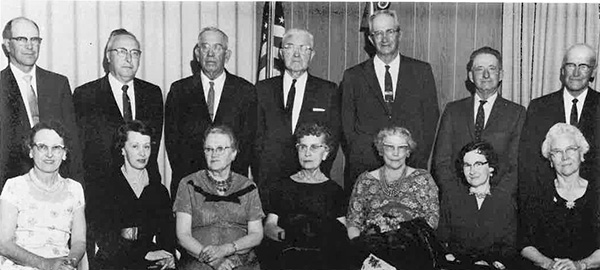
Courtesy photo from late 1950s/early 1960s
Late 1937: Easement soliciting began
To speed securing the right-of-way privileges and subscription of stock, the SLV REC board of directors hired “easement solicitors” to go into the field to get permission from landowners to put poles on
properties just inside the fence line. Leo Widger of Bowen, E.E. Cochran Jr. of Del Norte,
Web Allison of Monte Vista and V. Sherill Clark of La Jara took on this task.
For this work, the men were paid $5/day and five cents per mile
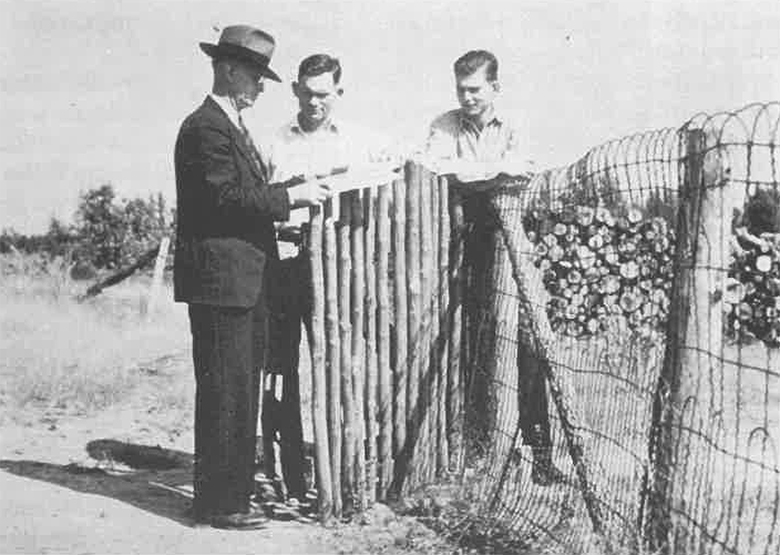
Late 1937: Construction bid awarded
Pueblo’s Driscoll Construction Company was awarded the project of 136 miles of electrical line in the San Luis Valley. Their bid of $98,074.34 for the “A” section included western red cedar poles, aluminum cable steel reinforced conductors, installation of transformers, steel structures for the substation and three 150 KVA transformers to be located at Zinzer Switch east of Monte Vista.
(San Luis Valley Historian, Volume XXVI #3, 1994)
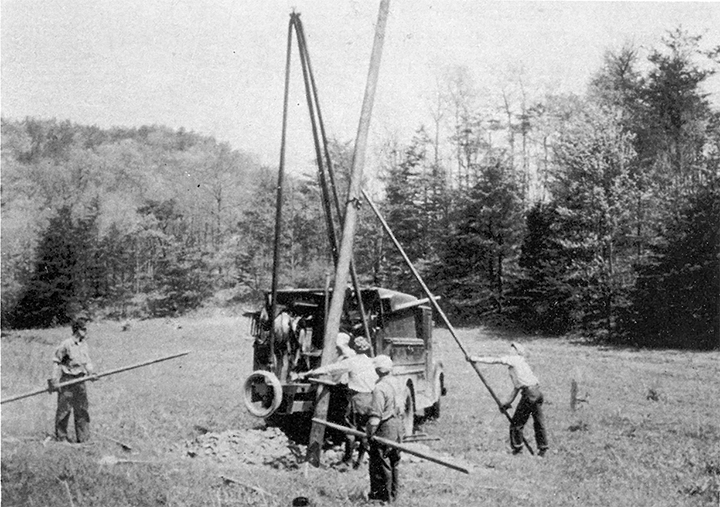
1938: Construction completed
Construction was first completed on “A” section which included lines reaching to South Fork and extending four miles north of Center, south to Bowen and Waverly (the Resettlement District) and south as far as the
Capulin-La Jara road. The 450 kVa substation transformer located at Zinzer Switch was the point electrical current was supplied by the Public Service Company to the REC.
The center of Sargent Community was already being served by Public Service.
According to first REC Superintendent Willard Johnson, the first pole was set on Paul Roberts ranch.
(San Luis Valley Historian, Volume XXVI #3, 1994)
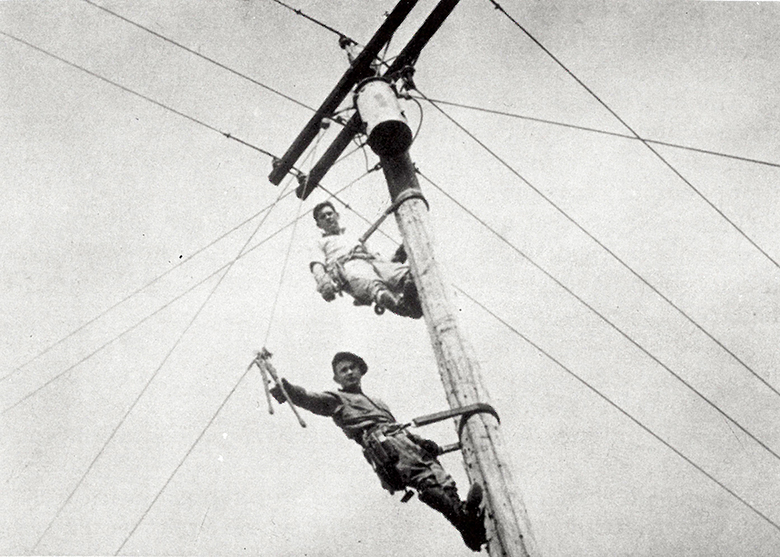
May 1938: Big day approaching
By May 20, 1938, there were 131 homes wired with the remainder of 300 to be wired and officially inspected. Light fixtures hung with bulbs in place long before the energizing set for June 25. San Luis Valley REC is the second oldest cooperative in Colorado; the first organized was Grand Valley Rural Power Lines, with offices in Grand Junction. (San Luis Valley Historian, Volume XXVI #3, 1994)
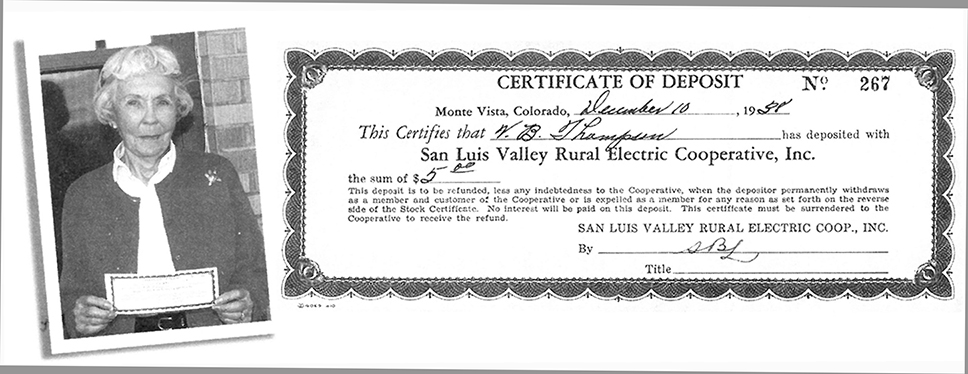
When Maxine Estes was cleaning out her lock box in 2002, she found the original certificate issued to her father, V. B. Thompson when he signed up for electricity with the San Luis Valley Rural Electric Cooperative, Inc. in 1938. (Newsboy, July 2002)
June 25, 1938: The big day has arrived!
At last the big day had arrived; on June 25, 1938, the lines in the first section “A” were energized. Imagine the excitement at having electric lights for the first time, having water pumps bring water into the house from the well and the unique new electrical appliances! For the farmer, a one-horse motor was the best hired hand he had ever had; it pumped water, sawed wood and lifted hay to the loft. Home life changed too; it was a toss-up whether electric irons or radios were the most popular item.
(San Luis Valley Historian, Volume XXVI #3, 1994)
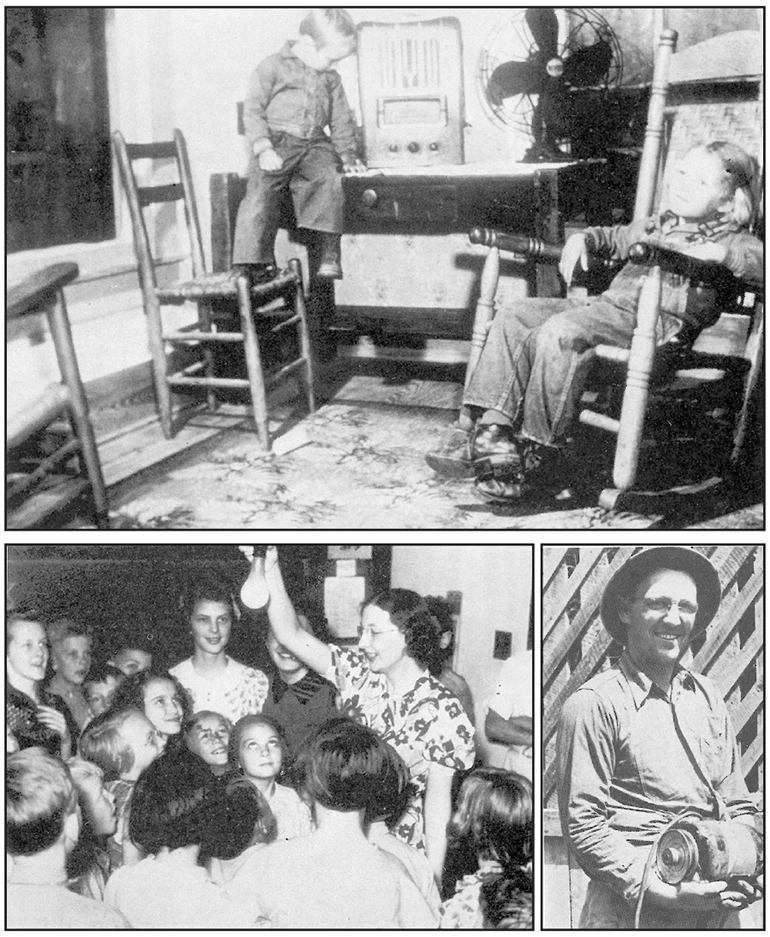
Electric system growing
At the regular board meeting on April 10, 1948 Manager Ray Villyard (pictured) recommended securing a
“two-way radio emergency station” to the board. With the completion of the “D” section, the cooperative
now had over 1,000 miles of line. (Newsboy, March 2004) 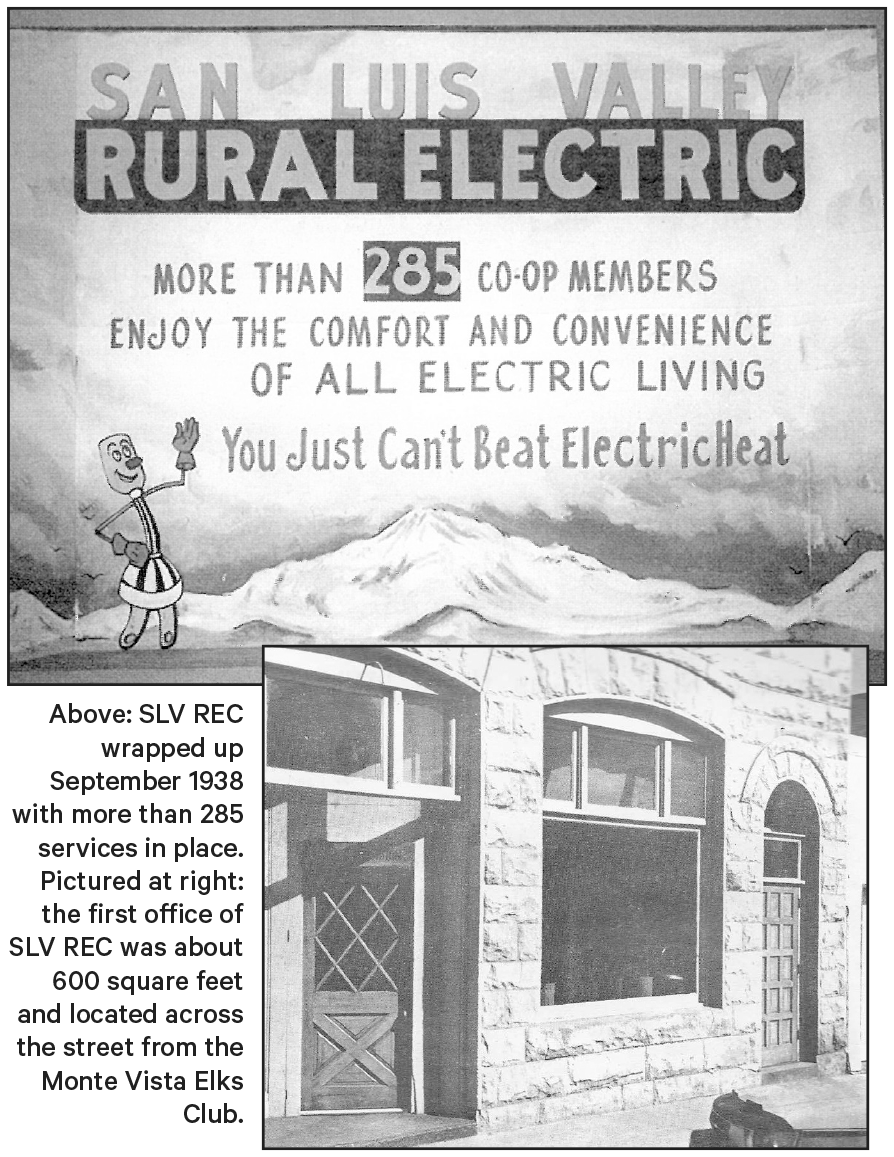
Electric system continues to grow
According to SLV REC’s first manager, Willard Johnson, the first lineman was Claus Rose, and he was paid $125/month. Willard was paid $150/month, and Mrs. Sara Loring, the office girl, was paid $50/month. Art Wolfe was hired as a second lineman in summer of 1938. They would ride to work on the back of a flatbed truck at
7 a.m. with the temperatures at 20 degrees below zero.
(Newsboy, September 2005, Volume 30, Issue 9; San Luis Valley Historian, Volume XXVI #3, 1994)
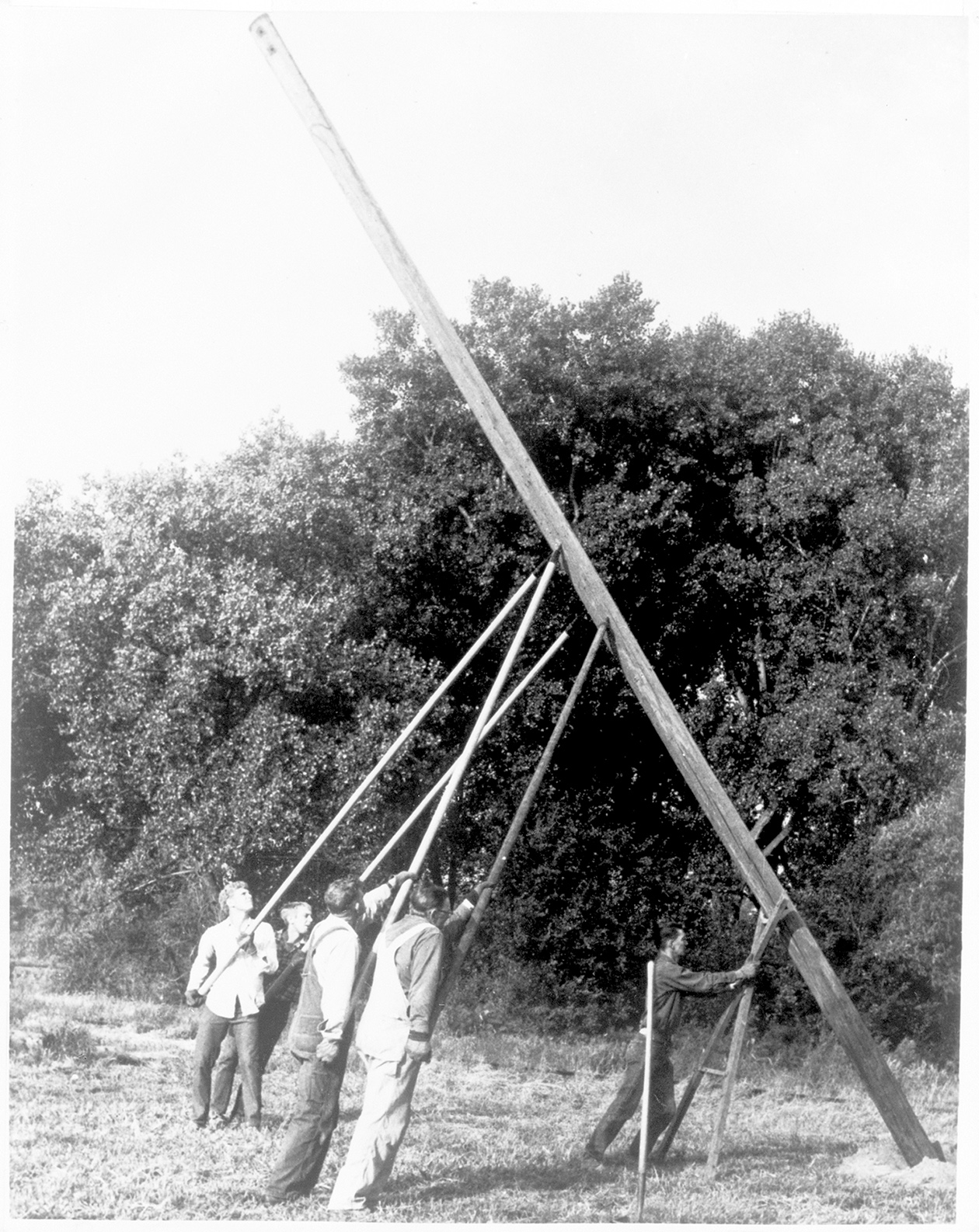
In the early days of electric co-ops, utility poles were put in place by hand – and a lot of hard work!
‘C,’ ‘D’ and ‘E’ sections added
The REC system continued to grow; the “C” section was built, and power was obtained from Public Service lines at a point west of Blanca extending south to the New Mexico state line in 1939.
“D” section was to extend to the farthest outlying areas— Saguache, Moffat, Villa Grove and taps off existing lines. It was delayed by World War II— put on hold until supplies (poles, wires, transformers, hardware, motors, etc.) were stockpiled after the war.
“E” section was instigated around 1943-44 to add extra wires for large irrigation pumps (three phase) for the central agricultural areas. This was a war production measure. The Zinzer substation was enlarged, voltage regulation and oil circuit breakers installed and many miles of single phase were changed to three phase for irrigation. When the contractor was finished, there were approximately 200 irrigation pumps.
One summer during this time (1944 or 1945) Public Service Company couldn’t supply the power needed to drive the many irrigation pumps. The overload tripped the breakers in the Alamosa plant, stopping all pumps, and the farmers had to return to the fields to restart their wells. A plan of rationing was worked out, and pumps were only run five days per week. This was a bit frustrating and dangerous for the farmers who were trying to water their crops during the height of the growing season. Continued expansion of REC lines eventually corrected this.
(San Luis Valley Historian, Volume XXVI #3, 1994)
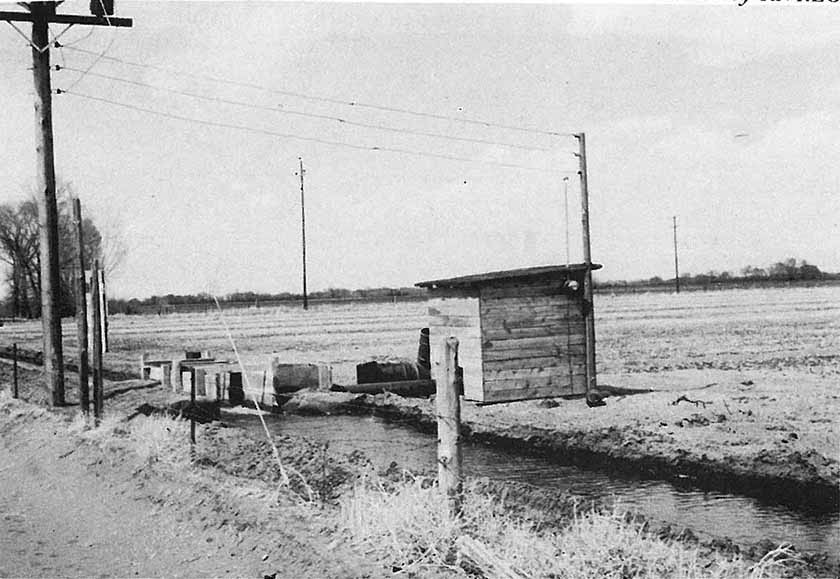
June 1939
In June 1939 an irrigation rate was adopted with a fixed charge of $6/season/hp and a use charge of 2.5 cents per Kwh for the first 100 Kwh, 1.7 cents for the second 100 Kwh and 1.2 cents for all additional use.
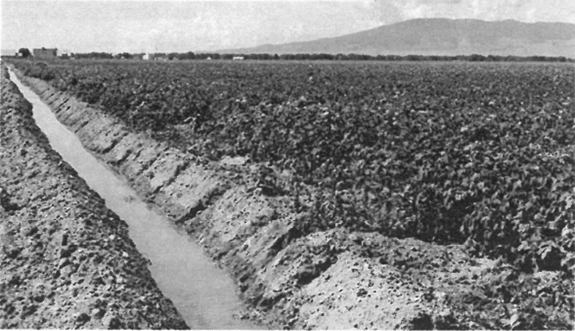
March 1941— A new location
In March 1941, SLVREC Superintendent Willard Johnson broached the subject of needing more office space. At the time, the office was located on Washington Street at the rear of a building. Johnson had located a larger facility on Adams owned by Roy David. The following month, the cooperative moved to the new facility with a rent of $40 per month.
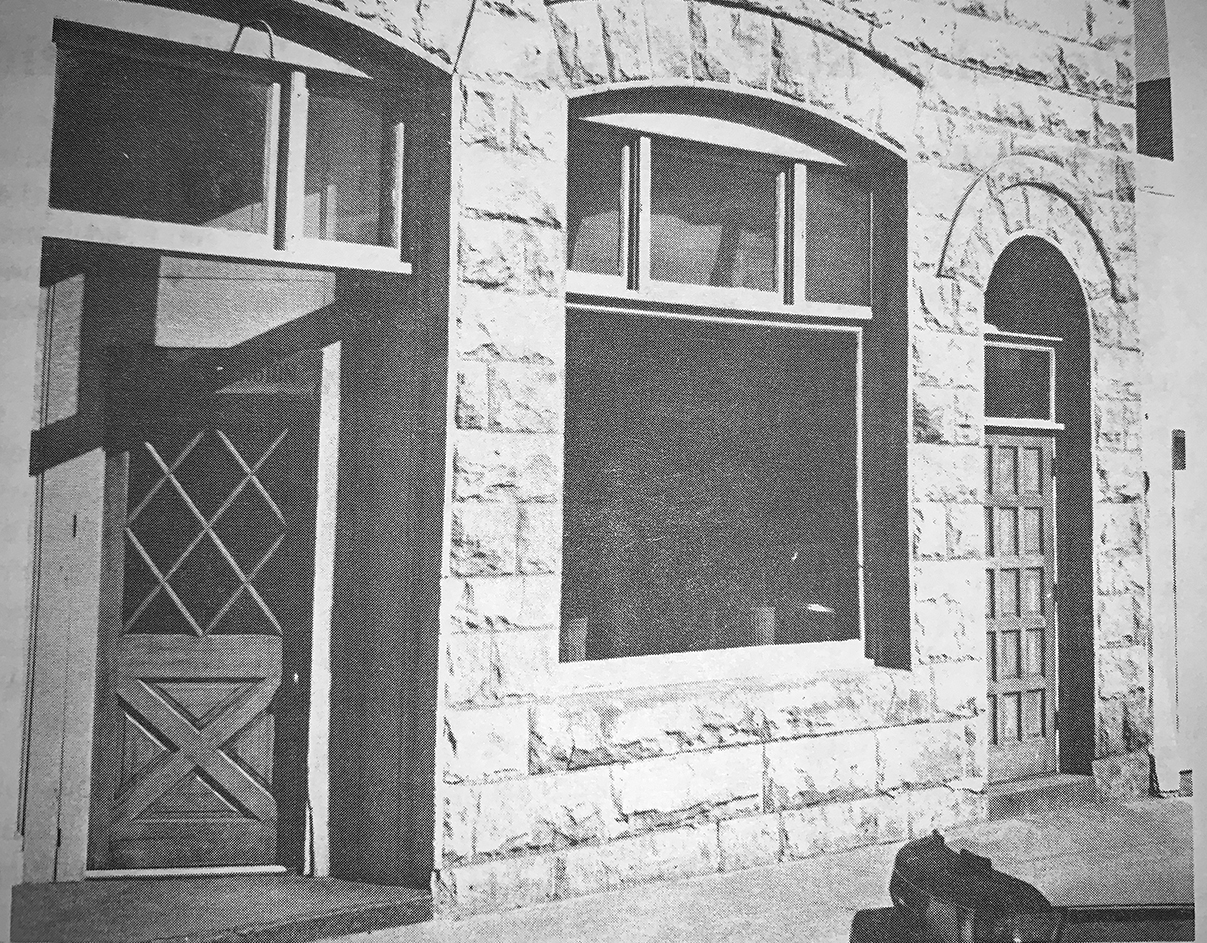
April 10, 1948— Radio requested
At the regular board meeting on April 10, 1948 Manager Ray Villyard (pictured) recommended securing a “two-way radio emergency station” to the board. With the completion of the “D” section, the cooperative now had over 1,000 miles of line. (Newsboy, March 2004)
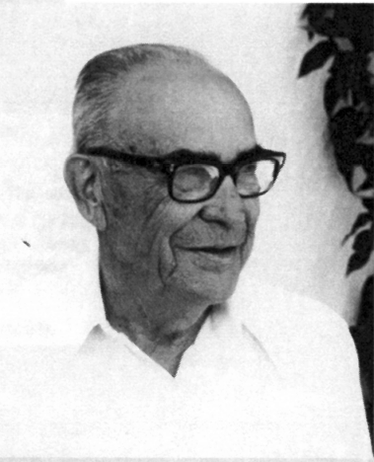
SUMMER 1952— NEW LINE TRUCK
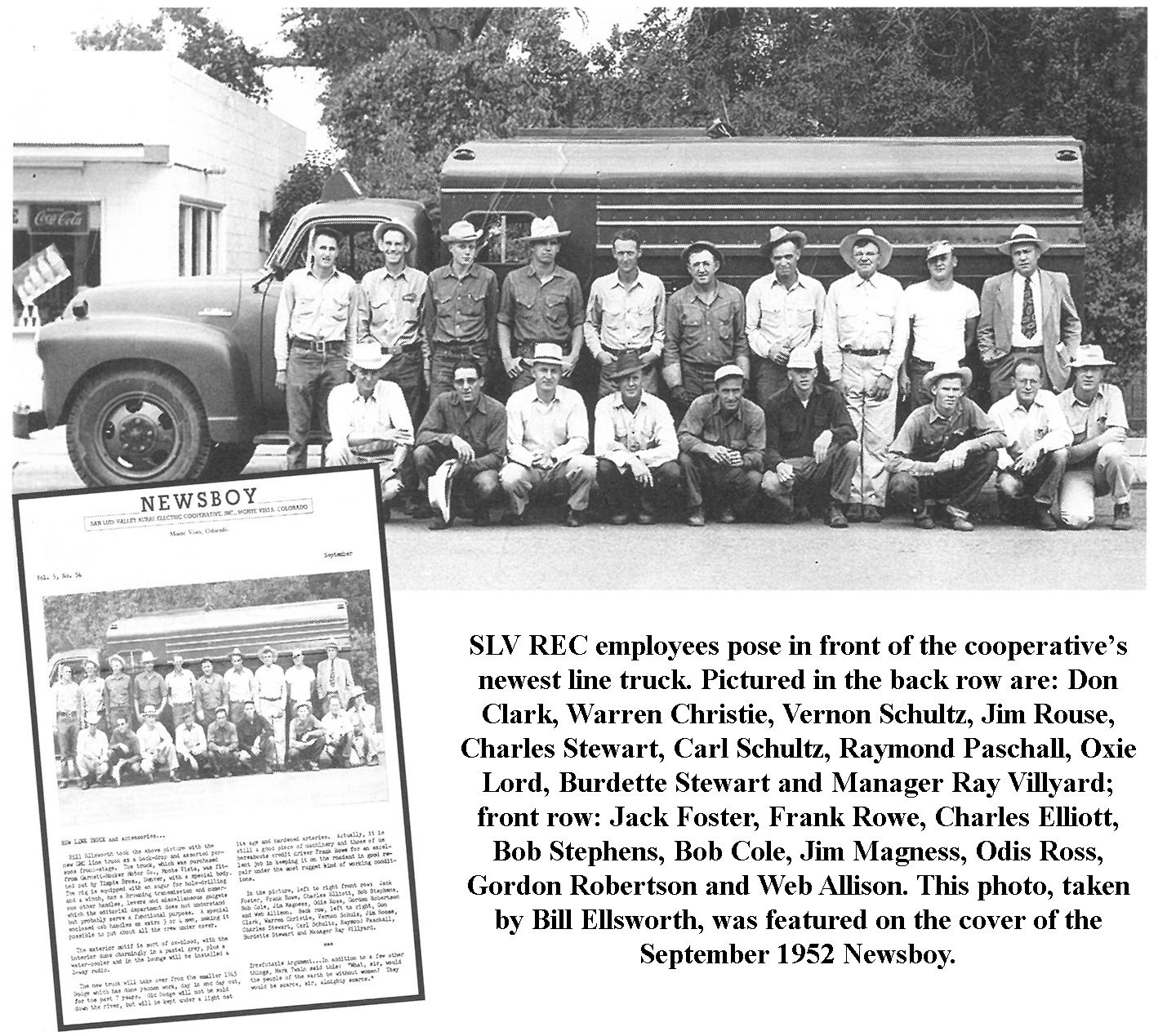
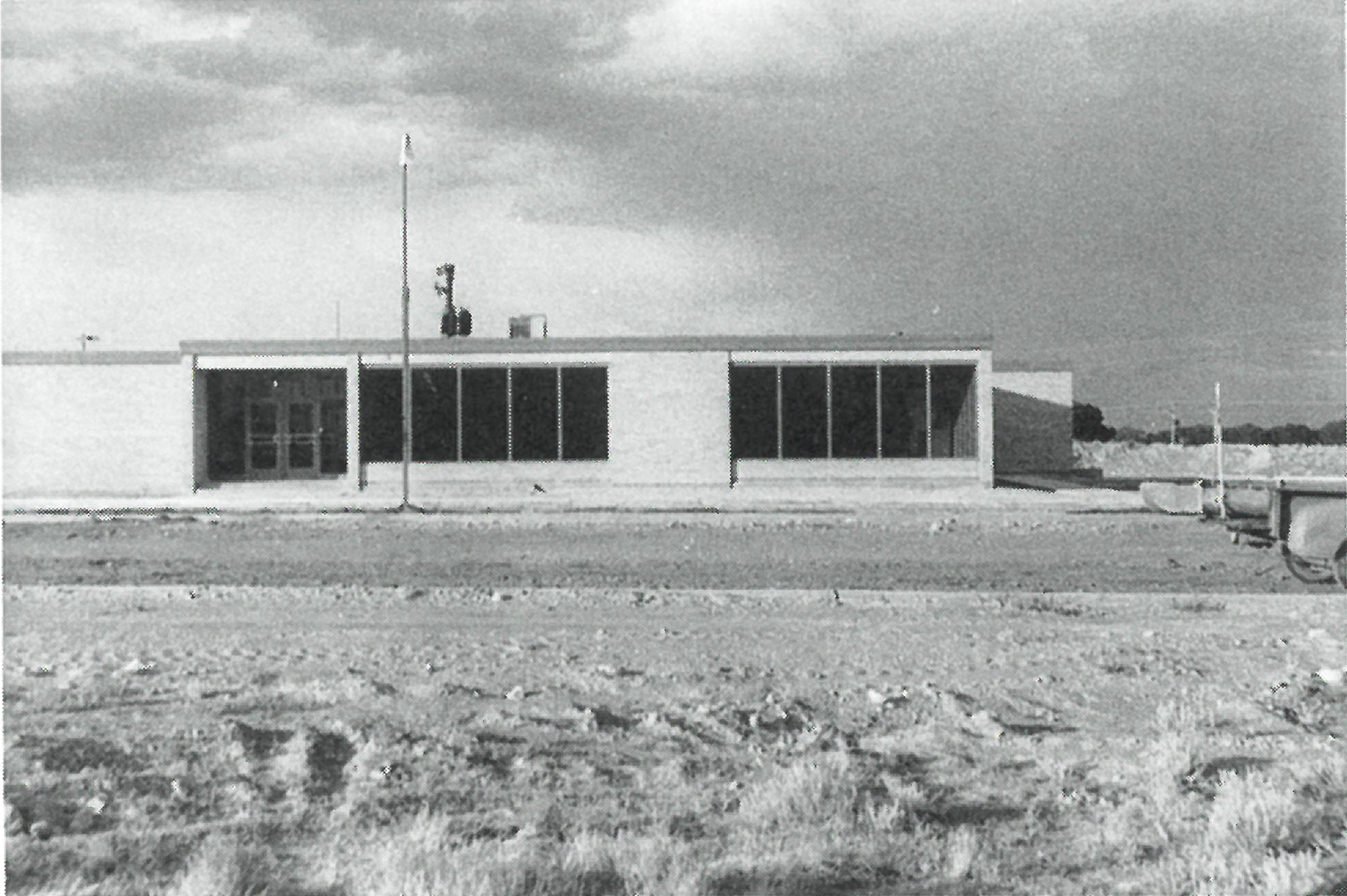
1956-ALMOST COMPLETE!
Electric use took a surge forward and people adopted an “electric” lifestyle, complete with radios, televisions and refrigerators; electric appliances and gadgets found homes in Valley households. To meet the Valley’s growing demand for power, a second transmission line was completed in 1956. That line, a 115 kV line, reached the Valley via Poncha Pass. It is owned by Xcel Energy; agreements allow REC to use power from this line.
The photo, at left, was taken in 1956, shortly before construction was completed on the current REC building. At the time the cooperative had 26 employees and served 3,592 meters. Today, the cooperative employs 53 and serves just under 13,000 meters.
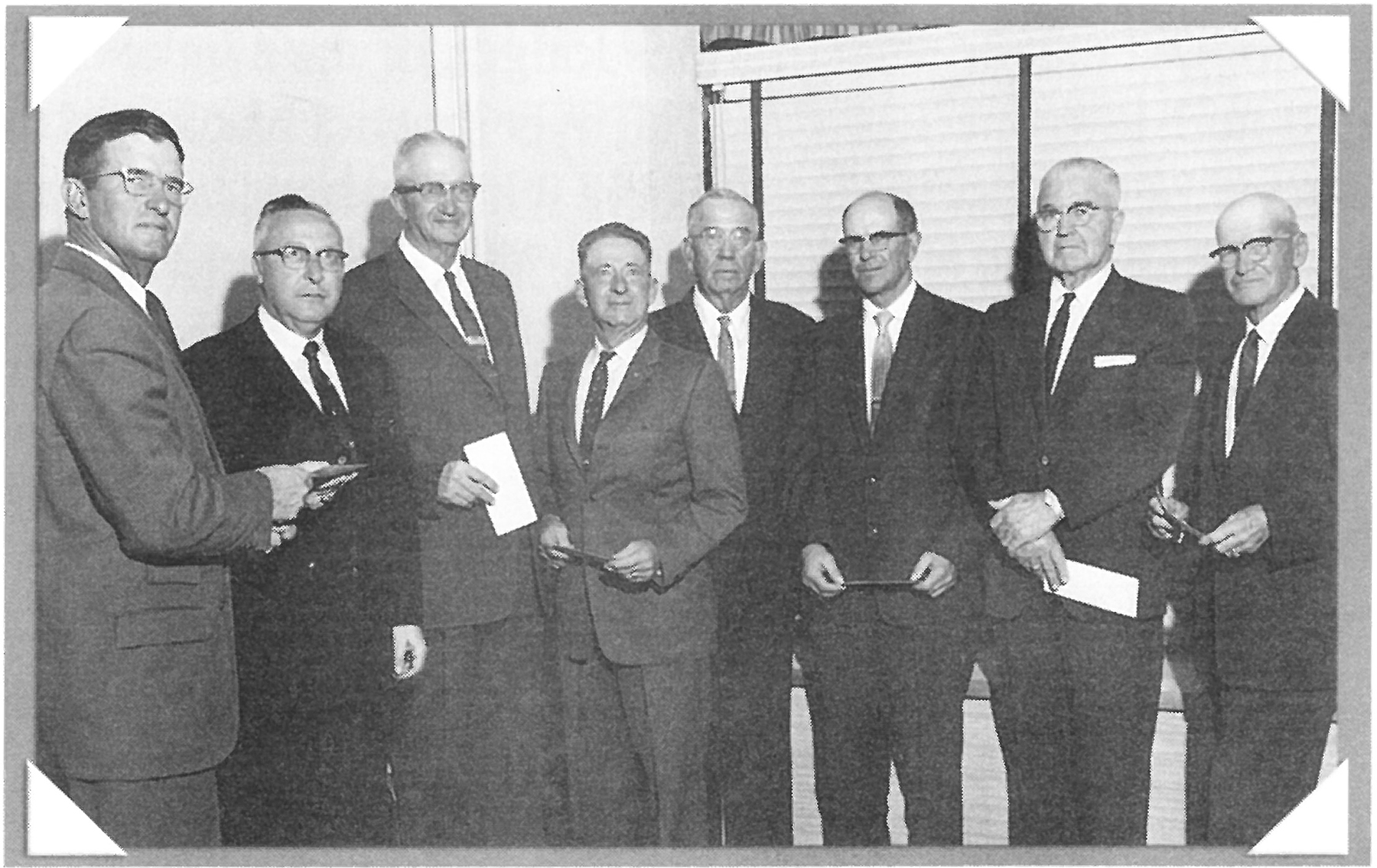
1950s— SLVREC pioneers honored
This photograph, probably taken in the 1950s, honored SLVREC’s pioneers. On the left, Director John R. Wright, hands a testimonial to the first REC Attorney, Ray Moses. Also pictured (continuing left to right) are J. V. Edgmand; Herbert Bowers; Mac Sutley; Frank McGee; Clyde Helms, Sr. and Arthur Robertson. Edgmand, Bowers, Sutley, Helms and Robertson were among the 14 incorporators. Edgmand, Sutley and Robert also served on the board of directors. McGee was Saguache County agent at the time of SLVREC’s founding and helped in its organization.
Courtesy Photo: Don Denney, Monte Vista
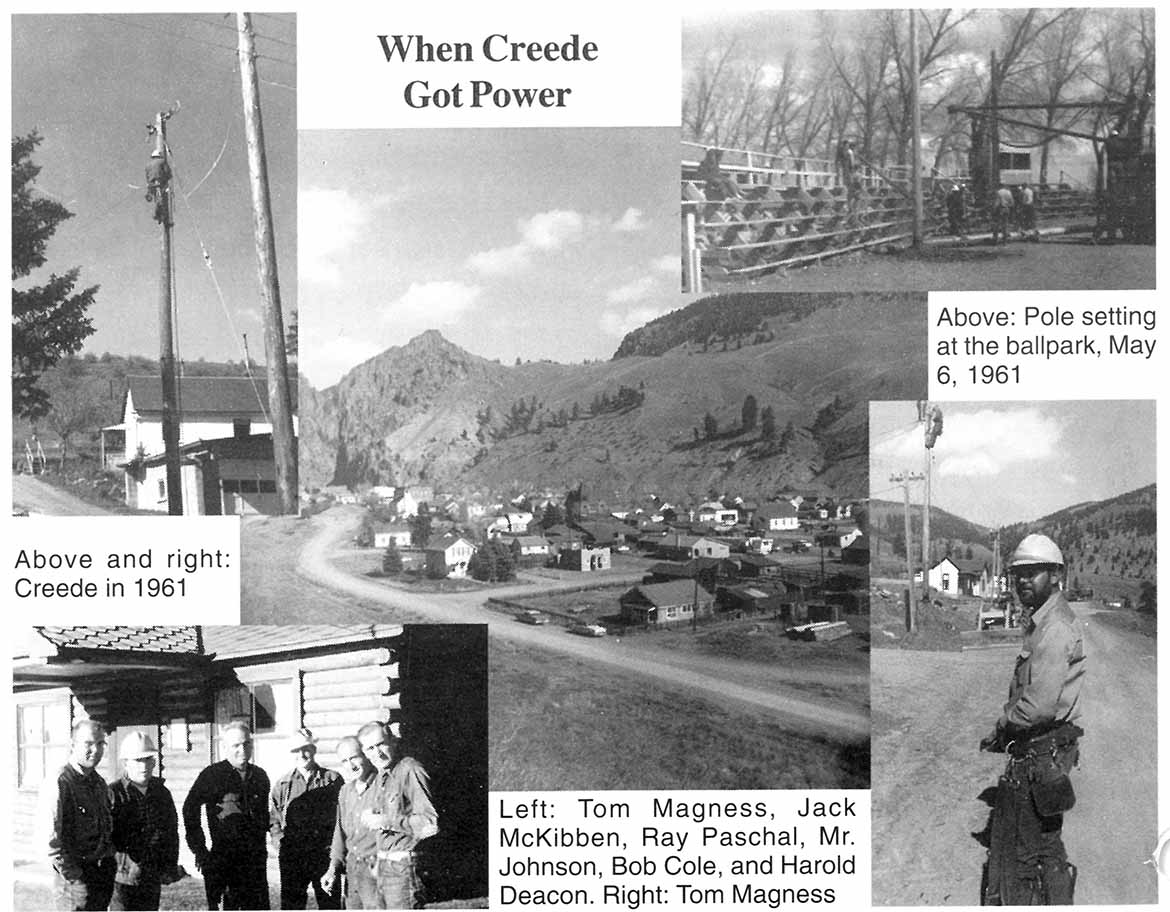
1961—Creede residents want SLVREC power
It wasn’t easy getting SLVREC power to Creede. The process began in June 1953; it took letters, years, meetings and money. In April, 1961 Creede Mayor Byron Fairchild Sr. and several Creede residents submitted letters to SLVREC requesting power to replace the town-owned generating system with SLVREC’s reliable power. Alfred E. Budaey wrote, “For the last 40 years we no more than get one [town] plant paid for then we have to buy another one. Our power fluctuates so much that it causes motors and lights to burn out. There isn’t enough power for electric stoves and water heaters for those who would like to install them.”
On May 17, 1961 SLVREC applied for a federal loan which included a request “for the purpose of providing electric service to the Town of Creede, Colorado and its inhabitants.”
Creede substation updated
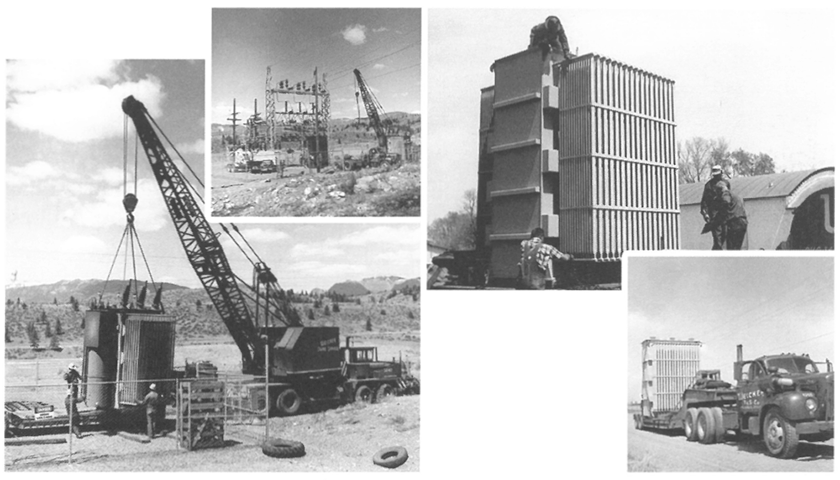
Every year, SLVREC repairs or replaces system components to keep up with increasing demand and to improve service. Some projects are more extensive than others. In 1969 the old transformer was pulled out of the Creede substation and replaced with a larger, more modern transformer.
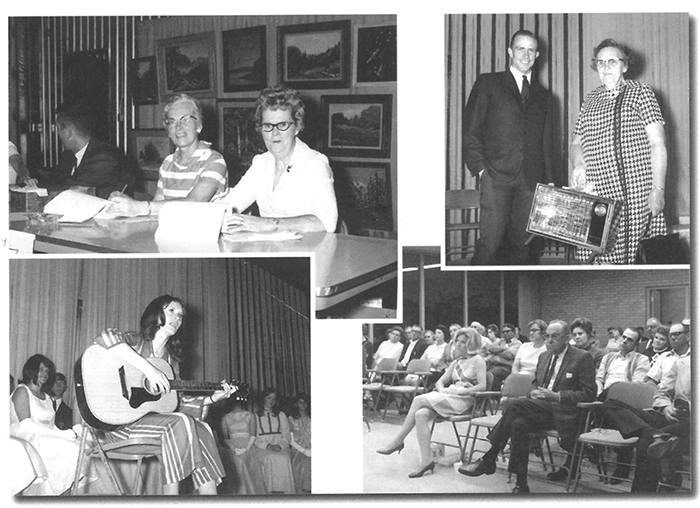
Annual meetings from years gone by
Top left: J. Batt and C. Rogers, 1970
Top right: Rocky presents a door prize to an unidentified member, 1970.
Bottom left: Pat Phillips provided some entertainment in 1970.Notice the pageant participants behind her.
Bottom right: About 50 people typically attended the annual meeting in the late 60s and early 70s. This photo was taken in 1972.
1970s.... photos courtesy of the Frank Rowe family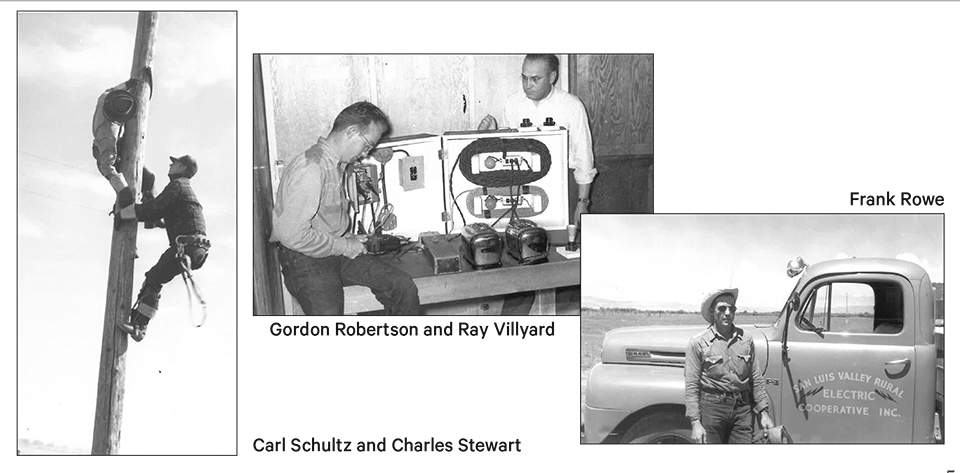
Mapping in 1975
In 1975, Andy Anderson and Jack Boutwell reviewed SLVREC’s map book. The book shows service locations and system information. Today’s information is computer generated and much more sophisticated. SLVREC employs a GIS specialist whose primary focus is mapping.

Photo taken from 2005 Newsboy
1978 Annual Meeting held at Elks Lodge

At the 41st Annual Meeting on June 6, 1978, members voted on a director for a six-year term for Costilla County.
Today, the terms are four years. Jerry Lorenz won that election. That year, members also voted for a bylaw change and they agreed to delete a clause that stipulated a mandatory retirement age of 64 for directors.

March 1979: Trekking up to Wolf Creek

In March 1979, SLVREC crews made several trips to an AT&T tower at the top of Wolf Creek. Lee Stehwien (above left) and the crew (center) bundled up for a trip to the top. That year was an exceptional year for snowfall. The rotary plow (above right) stayed busy keeping Highway 160 clear.

Center pivot installations increasing
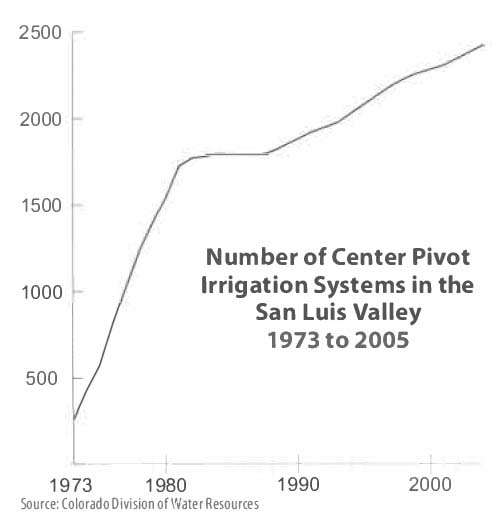
Farmers began installing center pivot irrigation systems. In 1973, there were 262 center pivot irrigation systems in the Valley. The following year, that number surged to 430. By 1980, there were 1,541 center pivots in the Valley. Most relied upon electricity.
SLVREC began to experience problems with voltage collapse during irrigation season. Voltage collapse occurs when power demand exceeds power supply at any point in time. The transmission system could not keep up. The Valley needed more power than the existing lines could supply.
By the mid-80s, plans for a third transmission line to serve the Valley were in place. By the end of that decade, a 230 kV line, jointly owned by Xcel Energy and Tri-State, also followed a route to the Valley over Poncha Pass. When this line was built, engineers anticipated it would meet Valley needs for several decades. In part, they were right. This line served the Valley well for almost two decades. However, the Valley’s growth exceeded everyone’s expectations.
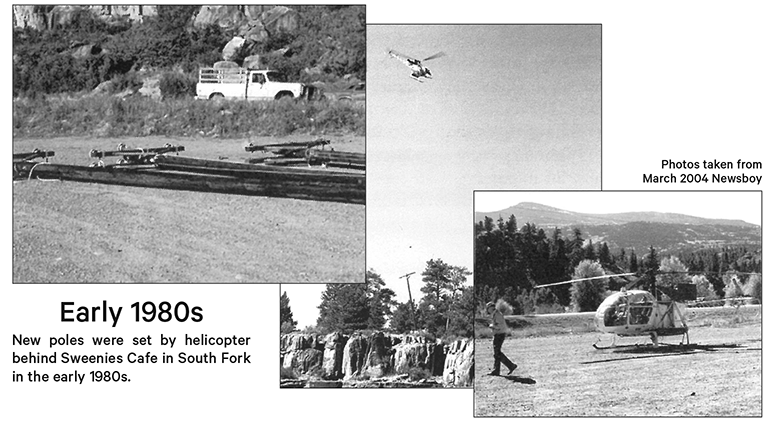
March 1985

Work on the 115 kV Hooper transmission line was completed by Larry Jones, Gary Fine, Eddie Pacheco, Dale Clare, Keith Mullenix, Ronnie Spencer and Jim Clare in March 1985.
Photos courtesy of Jim Clare

December 1985

Lawrence Heald and Rod Golden ventured to the top of Wolf Creek to work on the AT&T tower.
Photos courtesy of Jim Clare


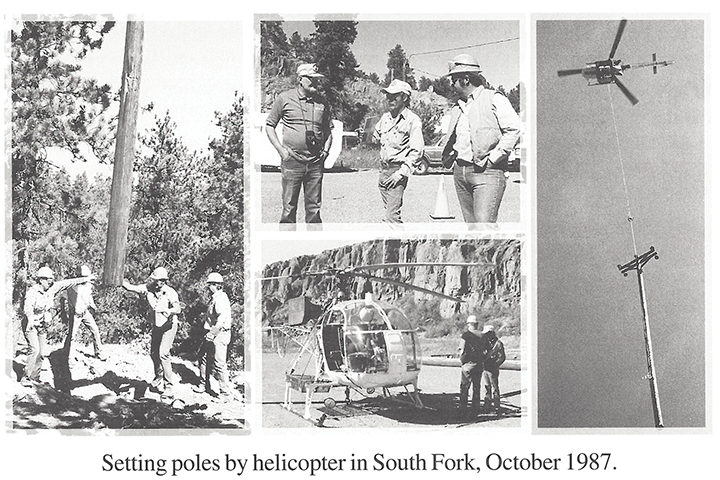
 During a break in the ceremonies at the SLVREC Annual Employee Christmas Party, these six service pin recipients consented to a solemn picture. From left to right: Larry Gonzales, 5 years; Keith Mullenix, 5 years; Dale Clark, 20 years; Rod Golden, 25 years; Director David Holland, 5 years and Ronnie Spencer, 5 years. The Christmas party was held at the Movie Manor in Monte Vista and very well planned and carried out by REC employees Tom Magness, Glen Marquez, Ronnie Spencer and Bonnie Denney.
During a break in the ceremonies at the SLVREC Annual Employee Christmas Party, these six service pin recipients consented to a solemn picture. From left to right: Larry Gonzales, 5 years; Keith Mullenix, 5 years; Dale Clark, 20 years; Rod Golden, 25 years; Director David Holland, 5 years and Ronnie Spencer, 5 years. The Christmas party was held at the Movie Manor in Monte Vista and very well planned and carried out by REC employees Tom Magness, Glen Marquez, Ronnie Spencer and Bonnie Denney.
March 1990

OId San Acacio saw some REC maintenance activity as Dale Clark’s line crew replaced almost 40 poles that had been in service since 1941. In the picture, Ronnie Spencer hoists the retired pole with the line truck while Glen Marquez guides it clear of the hole. The single phase hot line was simply pulled to one side (neutral line is shown in picture) while the pole was replaced, so no loss of service to the surrounding area was experienced. Dale said the local farmers were quick to speak for the old poles which were recycled into fence posts.

Incumbents prevailed in this year’s SLVREC Board of Directors’ election with Jerry Lorenz again chosen to represent District #2, Costilla County and David Holland, District #4, Alamosa County. Pictured above: Jerry and his wife, Joan (top); David and his wife, Barbara (below)
Shooting the rapids, Summer 1995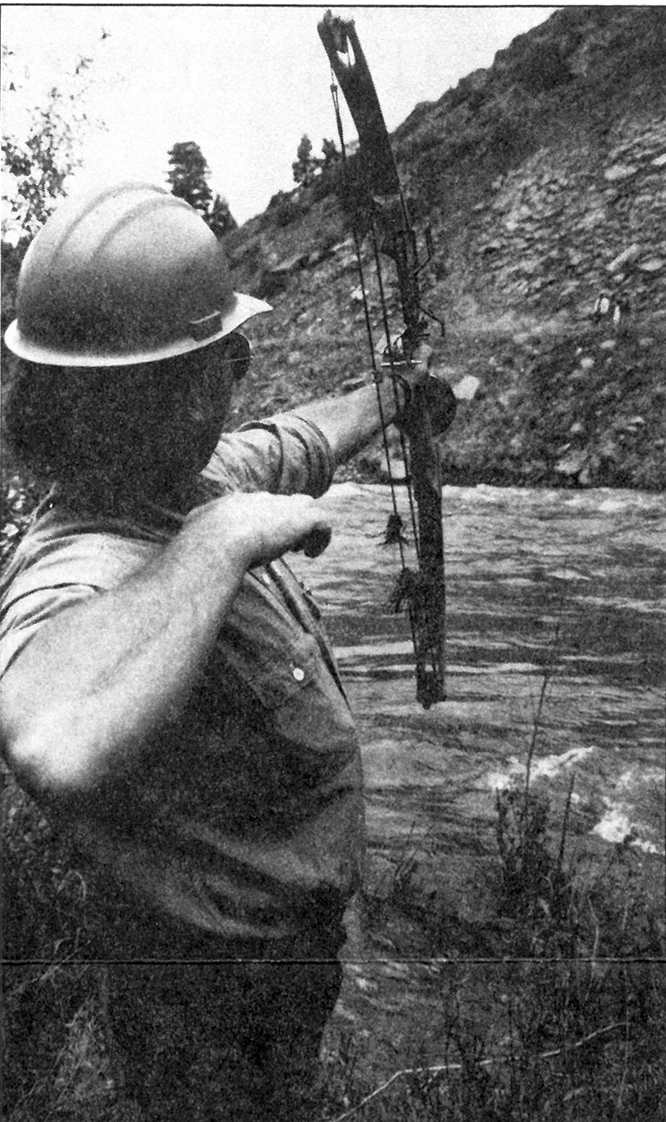
July 1995 Newsboy
Lineman Ronnie Spencer uses his bow and arrow to shoot a colored filament mounted on a reel to other REC linemen across the Rio Grande. Filament is attached to heavier line which in turn is hooked to a rope and then the power cable. Electrical service was lost when lightning parted a power line over the river a few miles above South Fork. Linemen devised a novel way of spanning the water. Ronnie says they have used it in other instances.
Work on the system continues unabated, January 1996

TSI, an independent contractor, working for REC, adds a three-phase line west of Del Norte as part of the Co-op’s two-year work plan, i.e., system improvement to provide greater capacity and ensure power quality. The old poles carrying the power lines are tilted to allow new poles to be placed without interrupting power.
REC attorney Rowe retires

From the May 1996 Newsboy
Gordon Rowe retired from his position after 25 years of service to the Cooperative. “I leave with fond memories. It is a wonderful and effective organization,” Gordon said. He also said that he will continue to practice law in partnership with his son Gordo in Monte Vista.
Board President Sam Holland presents Gordon with a certificate inscribed “25 Years of Legal Counsel.
REC employees serving the community

SLVREC is well represented on the Monte Vista Volunteer Fire Department with the fire chief, assistant fire chief and a 15-year member all REC employees. The Monte Vista Fire Department’s territory covers about 200 square miles ranging from brush to three-story senior citizen centers to the Monte Vista Airport; the department has 13 vehicles and a relatively new warehouse. Volunteers average 20-30 hours per month, fighting fires, extricating traffic victims, searching, training, educating the public and keeping their equipment ready.
Pictured above, Fire Chief and REC General Manager Chuck Archer, Meter Technician Scott Deacon, and Assistant Fire Chief and REC Operations Manager Jim Clare pause during a meeting.
From the October 1996 Newsboy
SCADA communications pole added

2000 annual meeting has record attendance
Board Secretary David Holland opened SLVREC’s 63rd annual meeting with an invocation. Board President Rick lnman welcomed members and guests. With a crowd of 435, this year’s annual meeting had the largest turnout in SLVREC history.
During the course of the evening, 32 door prizes were awarded. Dale Akers of South Fork was the lucky winner of the grand prize, a 1996 truck.
Members learned more about the activities of their cooperative through pres-entations by Co-CEOs Bill Green and John Villyard and Bob Peterson, manager of system control. Phil Buckman from Tri-State Generation & Transmission talked about recent outages.

From the December 2001 Newsboy
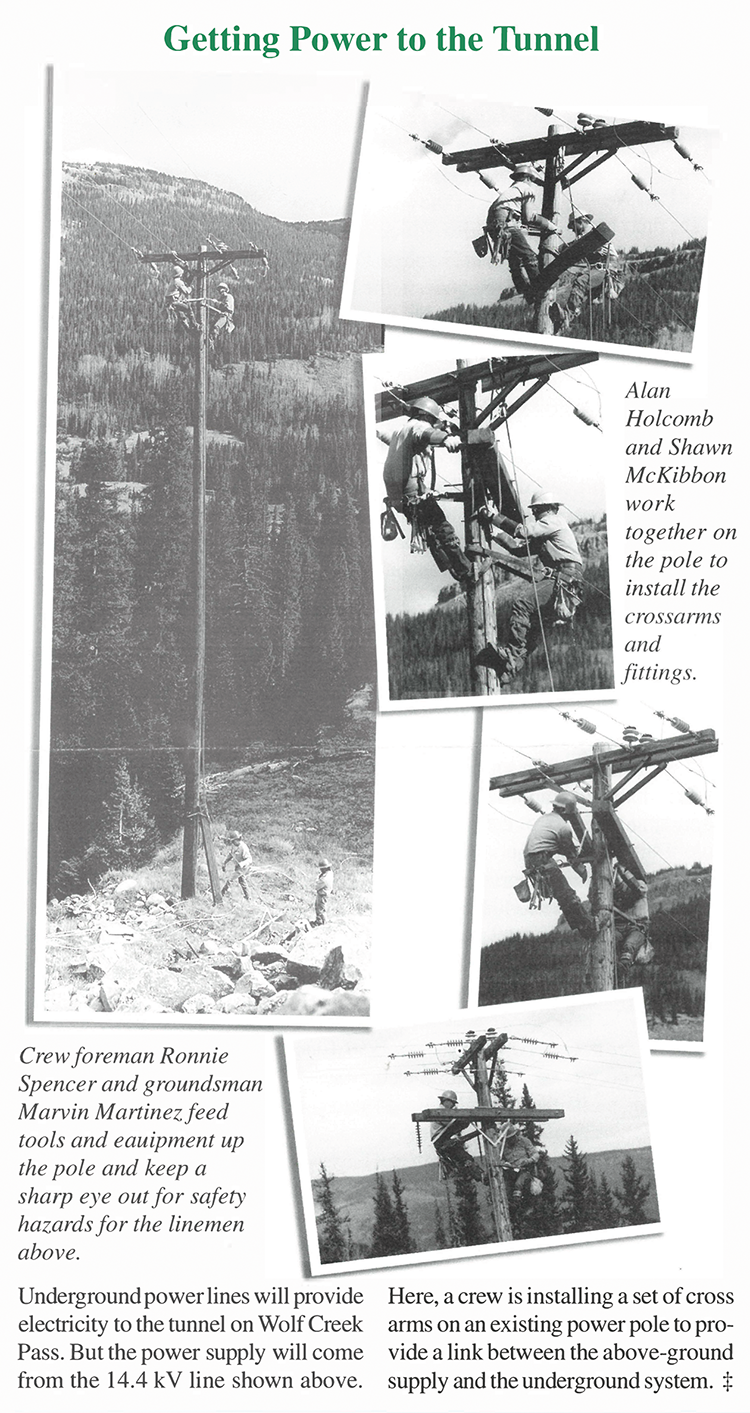
From the May 2002 Newsboy: What are those things?

From the October 2002 Newsboy: Coming up to code
In the last two years, repairing problems with SLVREC’s office has become a priority for the cooperative. The building was constructed in 1957. An addition was constructed in 1974.
In 1957, the cooperative employed 26 and served 3,592 meters. In 1974, 36 employees worked at SLVREC and the cooperative served 5,572 meters. Today, the cooperative employs 58 people and provides service to just over 11,000 meters.
A lack of both office space and warehouse space are the most obvious problems with the current facility. However; more serious issues include inadequate ventilation, a lack of fire walls within the building, and an inappropriate mix of occupancy types. For example, the shop is the primary location for welding and cutting. It is located next to several offices and storage areas for flammables.
Over the past 45 years, a number of offices have been added in locations that were not designed to house workers. The most significant problems occur near the warehouse. Offices in this area become polluted with diesel and gas exhaust in the mornings and evenings when crews are loading and unloading supplies. Additionally, clearances near electric supply panels are too tight. Other issues that must be addressed include roof leaks and inadequate heating and cooling systems.
Earlier this year, a comprehensive building review was completed and presented to the board of directors. A three-phase plan has been developed. This staged approach will allow the cooperative to remedy the worst problems first. In preparation for the implementation of the plan, the cooperative purchased the property adjacent to the current facility. Construction of a new shop will begin just west of the current office building this fall.
The new 50’ x 100’ shop building will have three drivethrough bays that will be large enough to accommodate the largest of the cooperative’ s vehicles— unlike the current shop. The new building will house all flammables in a secure room, thus reducing the potential for catastrophic records loss in the existing building and reducing the potential for injury to employees.
The financing mix for the project has not been fully decided. It will include some combination of deferred capital credits (maximum of two years), long-term financing, and use of reserve funds held for capital investment project needs like this one.
News & Media: E-News
Sign-Up For ENews
Sign me up to receive a digital version of The Newsboy every month!
Get Newsboy
Would you like to unsubscribe? Sorry to see you go!
Unsubscribe
Newsboy Archive
- Statement of Ownership
- December 2025
- November 2025
- October 2025
- September 2025
- August 2025
- July 2025
- June 2025
- Annual Report
- April 2025
- March 2025
- February 2025
- January 2025
REC featured on World's Greatest TV Show
How2Media, the producers of the television show “World’s Greatest!...,” recently featured San Luis Valley REC and Ciello to be a part of the popular television series. As part of the show, How2Media sent a film crew to spend time at the company’s facilities in the San Luis Valley, to find out what the story behind the story is with this great and still growing company and to show the “World’s Greatest!...” viewers why SLV REC/Ciello was selected as the best in their category, and therefore featured on the show.
Check out these renewable projects housed here the San Luis Valley!
Creede students find meaning in 3D printing
Students at Creede Schools enrolled in the 3D printing class worked to create surgical mask straps to donate to their area hospital and wrote accompanying letters of appreciation to show support to their front-line workers.
In these challenging times, our cooperative principle of Commitment to Community has greater meaning than ever before. Across our cooperative family, amazing work is being done by businesses, organizations, and individuals to support our communities in this time of need.
Join Renewable Randy as we explore the diverse renewable electric sources brought to you by Tri-State. Randy visits Creede as he explains "Where your energy comes from?"
Power-Up Radio Show
SLVREC’s Power-Up Radio Show runs every Thursday on KSLV AM/FM 1240/101.3 at 10:40 a.m, KYDN FM 95.3 at 12:40 p.m. and KSLV FM 96.5 2:40 p.m. or listen to it online here.
Power-Up Show: Mary's Story by Safe Electricity, 4-21-22
Power-Up Show: Make a Difference Day, 10-7-21
Power-Up Show: Cost of Service Study, 9-9-21
Power-Up Show: Energy Charge, 8-12-21
Power-Up Show: Demand Charge, 7-13-21
Power-Up Show: Rate Classes, 6-3-21
Power-Up Show: 2021 Scholarship winners, 5-13-21
Power-Up Show: Annual Meeting and more, 4-8-21
Power-Up Show: Ski-Hi update, 3-11-21
Power-Up Show: Electric Rates, 2-25-21
Power-Up Show: Christmas Parades, 12-10-2020
Power-Up Show: 2021 Scholarships, 11-12-2020
Power-Up Show: Logan Taggart, 10-22-2020
Power-Up Show: Donald Valdez, 10-15-2020
Power-Up Show: Suicide Prevention, 9-24-20
Power-Up Show: Corona Virus update, 3-12-20


